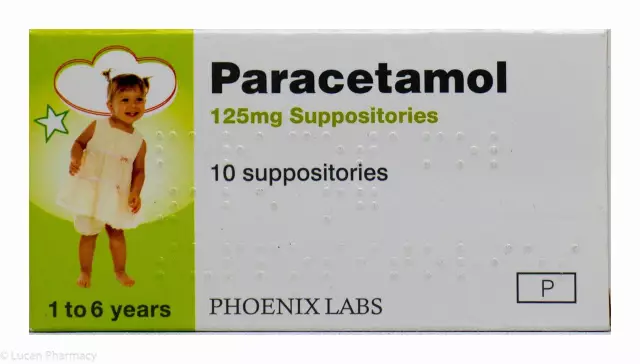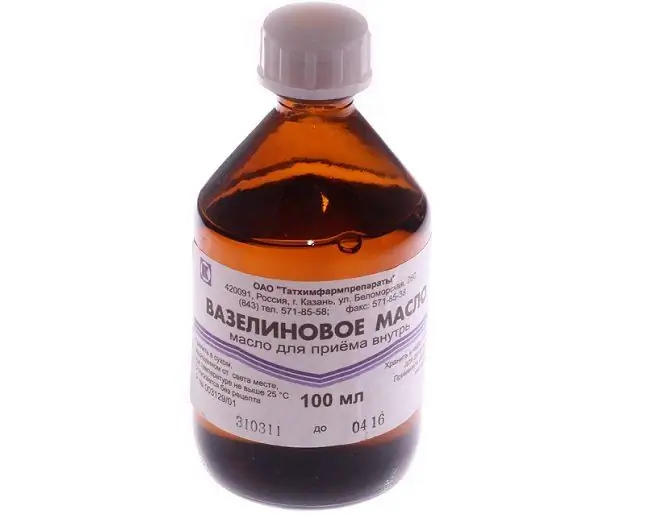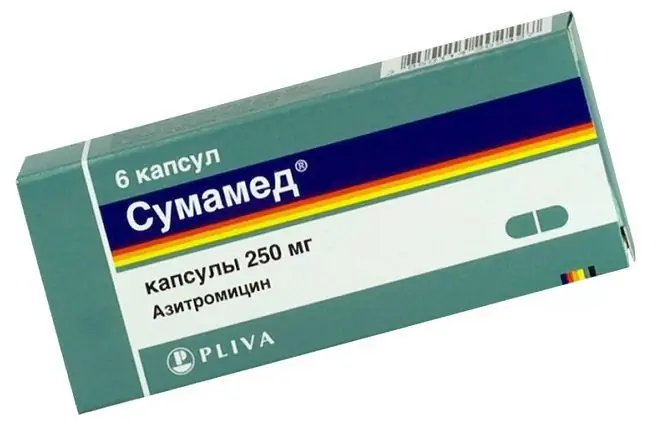- Author Rachel Wainwright [email protected].
- Public 2023-12-15 07:39.
- Last modified 2025-11-02 20:14.
Paracetamol Medisorb
Paracetamol Medisorb: instructions for use and reviews
- 1. Release form and composition
- 2. Pharmacological properties
- 3. Indications for use
- 4. Contraindications
- 5. Method of application and dosage
- 6. Side effects
- 7. Overdose
- 8. Special instructions
- 9. Application during pregnancy and lactation
- 10. Use in childhood
- 11. In case of impaired renal function
- 12. For violations of liver function
- 13. Drug interactions
- 14. Analogs
- 15. Terms and conditions of storage
- 16. Terms of dispensing from pharmacies
- 17. Reviews
- 18. Price in pharmacies
Latin name: Paracetamol Medisorb
ATX code: N02BE01
Active ingredient: paracetamol (Paracetamol)
Manufacturer: CJSC "MEDISORB" (Russia)
Description and photo update: 2019-13-11
Prices in pharmacies: from 28 rubles.
Buy

Paracetamol Medisorb is a drug from the group of non-narcotic analgesics. It has an analgesic, weak anti-inflammatory and antipyretic effect.
Release form and composition
The drug is produced in the form of tablets, flat-cylindrical, round, with a line and a chamfer, white or almost white (7, 10 or 14 pcs. In blisters or 10 pcs. In blister-free contour packages, in a cardboard box 1, 2, 3, 4, 5 or 10 contour packs and instructions for the use of Paracetamol Medisorb).
Composition for 1 tablet:
- active ingredient: paracetamol - 200 mg or 500 mg;
- auxiliary components: stearic acid, low molecular weight polyvinylpyrrolidone, potato starch and talc.
Pharmacological properties
Pharmacodynamics
The drug has antipyretic, weak anti-inflammatory and analgesic effects.
Paracetamol acts on the centers of thermoregulation and pain, blocking cyclooxygenase I and cyclooxygenase II (mainly in the central nervous system). In tissues and organs, cellular peroxidases practically neutralize the inhibitory effect of paracetamol on cyclooxygenase. This explains the almost complete lack of anti-inflammatory effect.
Due to the fact that paracetamol does not block the synthesis of prostaglandins in peripheral tissues, there is no negative effect of the drug on the mucous membrane of the digestive tract and water-salt metabolism (water and sodium are not retained in the body).
Pharmacokinetics
Paracetamol is rapidly absorbed from the digestive tract. The degree of drug absorption is high. After 0.5-2 hours, the maximum concentration of the active substance is observed in the blood plasma (5-20 μg / ml). The therapeutically effective plasma concentration of the drug is achieved when using doses of at least 10-15 mg / kg body weight.
About 15% of paracetamol binds to plasma proteins. The drug passes through the blood-brain barrier. Less than 1% of the dose taken by her penetrates into the breast milk of a lactating woman.
Paracetamol metabolism occurs in the liver. The main metabolic pathways: conjugation with sulfuric acid, conjugation with glucuronic acid, oxidation by microsomal enzymes. As a result of oxidation, toxic metabolites are formed, which subsequently conjugate with glutathione and then with cysteine and mercapturic acids. Basic isozymes of cytochrome P 450that are involved in the oxidation of paracetamol are: CYP2E1 (plays a major role), CYP1A2 and CYP3A4 (play minor roles). If a patient is deficient in glutathione, toxic metabolites accumulate and can cause damage and further necrosis of liver cells (hepatocytes). In addition to the main metabolic pathways, there are additional pathways: methoxylation to 3-methoxyparacetamol and hydroxylation to 3-hydroxyparacetamol. The resulting metabolites are subsequently conjugated with sulfuric or glucuronic acid (glucuronidation predominates in adult patients, and sulfation in young children, including premature infants). The pharmacological activity of conjugated metabolites is low.
About 3% of the taken paracetamol is excreted unchanged, and the main part is in the form of metabolites, among which conjugates predominate.
In elderly patients, the clearance of paracetamol decreases and its half-life increases.
Indications for use
Paracetamol Medisorb is recommended to be taken if necessary:
- relief of pain of various etiologies (headache, toothache, muscle pain, migraine, sore throat, menstrual pain, back pain);
- symptomatic therapy of febrile syndrome (as an antipyretic agent);
- decrease in fever in case of colds and flu.
The drug is intended to eliminate pain at the time of drug administration, it does not affect the progression of the underlying disease.
Contraindications
Absolute:
- severe renal dysfunction;
- severe liver dysfunction;
- children under 3 years of age (only for this dosage form of paracetamol);
- hypersensitivity to the main or auxiliary components of the tablets.
Relative (Paracetamol Medisorb is used with caution, after consulting a specialist):
- renal failure of mild to moderate severity;
- mild to moderate liver failure;
- bulimia, anorexia, extreme depletion of the body (due to insufficient supply of glutathione in the liver);
- benign hyperbilirubinemia (Rotor, Dubin-Johnson, Gilbert syndromes);
- alcoholic liver damage, alcoholism;
- a decrease in the volume of circulating blood (hypovolemia);
- dehydration of the body;
- viral hepatitis;
- lack of the enzyme glucose-6-phosphate dehydrogenase;
- During pregnancy and breastfeeding;
- elderly age.
Paracetamol Medisorb, instructions for use: method and dosage
Paracetamol Medisorb tablets are taken orally, 1-2 hours after meals. They should be taken with plenty of water or other liquid. Taking the drug immediately after a meal slows down the onset of the therapeutic effect.
A single dose is 200 mg or 500 mg, the frequency of use is up to four times a day.
Adult patients and children over 12 years of age (weighing more than 40 kg) are usually prescribed 500-1000 mg of paracetamol up to four times a day. It is necessary to maintain an interval of at least 4 hours between doses of the drug (for adolescents 12-17 years old - at least 6 hours).
Maximum dosages of Paracetamol Medisorb: single - 1000 mg, daily - 4000 mg.
It is recommended to use the drug as an anesthetic for no more than 5 days, and as an antipyretic drug - no more than 3 days. Further therapy is possible only as directed by a doctor and under his supervision.
For children, the dose of paracetamol is calculated taking into account body weight. Maximum doses: single - 15 mg / kg four times a day every 6 hours, daily - 60 mg / kg.
Recommended dosages of Paracetamol Medisorb for children, depending on age and body weight:
- children aged 3 to 6 years (15-21 kg): single dose - no more than 15 mg / kg, daily dose - no more than 60 mg / kg (in children 3-6 years old, it is advisable to use other dosage forms for more accurate dosing paracetamol);
- children aged 6 to 9 years: 250 mg up to four times a day with an interval between doses of at least 4 hours; maximum doses: single - 250 mg, daily - 1000 mg;
- children aged 9 to 12 years: 500 mg up to four times a day with an interval between doses of at least 4 hours; maximum doses: single - 500 mg, daily - 2000 mg.
Without a doctor's prescription, Paracetamol Medisorb is not recommended for children for more than 3 days.
Do not exceed the above doses and independently increase the duration of treatment. In case of accidental overdose, it is necessary to urgently consult a doctor, even if the patient's condition has not worsened, as there is a risk of serious liver damage.
For persons with liver failure, decompensated or chronic liver diseases, chronic alcoholism, as well as dehydration and extreme exhaustion, the daily dose of Paracetamol Medisorb should not exceed 3000 mg.
Side effects
Paracetamol Medisorb is generally well tolerated when used in recommended doses. Possible adverse reactions from the following systems and organs:
- digestive system: rarely - nausea and vomiting, abdominal pain;
- hepatobiliary system: rarely - increased activity of liver enzymes; with an unknown frequency - hepatitis, liver failure, liver necrosis;
- respiratory system: very rarely - aspirin bronchial asthma (in persons with hypersensitivity to nonsteroidal anti-inflammatory drugs);
- nervous system: with an unknown frequency - psychomotor agitation, dizziness, disorientation in space (when using large doses);
- lymphatic system and blood: very rarely - thrombocytopenia, neutropenia, anemia, agranulocytosis, leukopenia; with an unknown frequency - increased content of methemoglobin in the blood, sulfhemoglobinemia;
- skin and subcutaneous fat: with an unknown frequency - exanthema;
- immune system: rarely - pruritus, urticaria, skin rash, Quincke's edema; very rarely - Lyell's syndrome, Stevens-Johnson syndrome, acute generalized exanthematous pustulosis;
- other reactions: with an unknown frequency - an increase in creatinine levels.
With long-term use of Paracetamol Medisorb in large doses, the risk of impaired renal and liver function increases (nonspecific bacteriuria, renal colic, papillary necrosis, interstitial nephritis), as well as a change in the peripheral blood picture (regular monitoring is required).
Overdose
The clinical symptoms of an acute paracetamol overdose develop within 24 hours after taking the drug. The patient develops gastrointestinal disorders (loss of appetite, vomiting, nausea, abdominal pain, discomfort in the abdominal cavity), the skin becomes pale. In adults, with a single intake of 7.5 g of paracetamol or more (in children, with a simultaneous intake of 140 mg / kg or more), destruction of hepatocytes is observed, which leads to complete and irreversible liver necrosis, the development of liver failure, encephalopathy and metabolic acidosis. The listed phenomena can cause coma and further death. An increase in the activity of liver enzymes, the level of bilirubin, the concentration of lactate dehydrogenase and a decrease in the content of prothrombin are noted only 12-48 hours after an overdose. The first clinical symptomsindicative of liver damage, appear only 2 days after an overdose, and reach a maximum on 4-6 days.
In children, elderly patients, patients with malnutrition, people with liver diseases due to chronic alcoholism and patients taking simultaneously with paracetamol inducers of microsomal liver enzymes, in case of an overdose of the drug, intoxication with the development of liver failure, fulminant hepatitis or cholestatic hepatitis is possible, sometimes with a fatal outcome … In addition, the development of acute renal failure with tubular necrosis (manifested by pain in the lumbar region, proteinuria and hematuria) is likely. In this case, liver damage may be absent. In some patients, pancreatitis and cardiac arrhythmias were recorded against the background of an overdose.
The patient should be hospitalized immediately. Before starting therapy, the concentration of paracetamol in plasma is determined in advance. In the first 8 hours, the introduction of acetylcysteine and methionine (precursors of the synthesis of glutathione and donors of SH-groups) is effective. Further treatment is symptomatic and depends on the concentration of the active substance in the blood.
The activity of liver microsomal enzymes is determined at the beginning of therapy and then every 24 hours. Usually this indicator is normalized in the first 1-2 weeks of treatment. In particularly severe cases, liver transplantation may be required.
special instructions
If, when taking Paracetamol Medisorb, the patient's condition does not improve or the headache becomes constant, you should consult a doctor.
With a deficiency of glutathione, the risk of overdose increases, so the drug is used with caution. Glutathione deficiency can occur with fasting, eating disorders, wasting, HIV infection, and cystic fibrosis. In all these cases, severe liver damage is possible even with small drug overdose (5 g or more).
The occurrence of any hypersensitivity reactions requires immediate discontinuation of the drug. Therapy must also be suspended if acute viral hepatitis is detected in the patient.
Paracetamol Medisorb should not be taken together with other medicinal products containing paracetamol.
The patient should inform the doctor about taking paracetamol before testing for glucose and uric acid in the blood.
Alcoholic beverages should not be consumed during treatment with the drug. Patients prone to chronic alcoholism should refrain from taking paracetamol (due to possible toxic liver damage).
Influence on the ability to drive vehicles and complex mechanisms
Given the likelihood of adverse reactions when using Paracetamol Medisorb, care must be taken while driving a car and when operating other potentially dangerous and complex machinery.
Application during pregnancy and lactation
Paracetamol Medisorb can be taken by pregnant women, since no negative effects on pregnancy or fetal development have been identified in the studies. The drug is recommended to be used in the minimum effective doses and as short a course as possible.
Paracetamol in small amounts is secreted in breast milk, however, no negative effect on the child's body has been identified.
Pediatric use
Paracetamol Medisorb tablets are contraindicated in children under 3 years of age.
With impaired renal function
The drug is contraindicated in severe renal impairment. Paracetamol should be used with caution in patients with mild to moderate renal impairment.
For violations of liver function
Paracetamol Medisorb is contraindicated in severe hepatic impairment. Patients with mild to moderate hepatic impairment should use paracetamol with caution.
Drug interactions
Medicines and substances with potential hepatotoxicity (ethanol, phenytoin, phenobarbital, isoniazid, rifampicin, carbamazepine, etc.) increase the toxicity of paracetamol and can cause its overdose even when low doses are used (liver function must be monitored).
Phenytoin reduces the effectiveness of paracetamol, so patients taking phenytoin should avoid frequent use of paracetamol, especially in high doses.
Paracetamol Medisorb can increase the concentration of chloramphenicol in the blood plasma, reduce the effectiveness of uricosuric drugs, increase the risk of neutropenia when used together with zidovudine, and increase the anticoagulant effect of indirect anticoagulants (with regular use for 4 or more days).
Probenecid reduces the clearance of paracetamol by almost 2 times, which requires a decrease in the dose of the latter. Drugs that slow down gastric evacuation (for example, propantheline) reduce the rate of absorption of paracetamol and may delay the onset of its therapeutic effect. Barbiturates reduce the effectiveness of paracetamol. Domperidone and metoclopramide increase the rate of absorption of the drug and accelerate the onset of its antipyretic and analgesic effects.
With prolonged combined use with non-steroidal anti-inflammatory drugs, the risk of analgesic nephropathy and papillary necrosis of the kidneys increases, and the onset of end-stage renal failure also accelerates.
In the case of simultaneous long-term use of large doses of paracetamol in conjunction with salicylates, the risk of developing cancer of the bladder or kidney increases.
Myelotoxic agents increase the hematotoxicity of Paracetamol Medisorb, and diflunisal - its hepatotoxicity.
Analogs
Paracetamol Medisorb analogues are Daleron, Apap, Xumapar, Paracetamol, Paracetamol Velpharm, Paracetamol-UBF, Paracetamol Avexim, Paracetamol-Hemofarm, Paracetamol-LekT, Panadol, Efferalgan, Strimol, etc.
Terms and conditions of storage
Keep out of the reach of children. Store in a dark, dry place at a temperature not exceeding 25 ° C.
The shelf life of the tablets is 3 years.
Terms of dispensing from pharmacies
Available without a prescription.
Reviews of Paracetamol Medisorb
There are a lot of reviews about Paracetamol Medisorb, since it is included in the list of medicines that should be in every first-aid kit. Patients speak well of the pills, as they help with pain of various origins, act quickly, are easy to use, inexpensive and affordable.
The main disadvantages, according to users, include the existing contraindications and side effects, as well as the bitter taste of the tablets. Some patients note the weak effect of the drug in severe pain.
Price for Paracetamol Medisorb in pharmacies
The price of Paracetamol Medisorb in the form of 500 mg tablets is about 5 rubles. per pack with 10 tablets, 10-12 rubles. per pack with 20 tablets and 25-30 rubles. per pack with 30 tablets.
Paracetamol Medisorb: prices in online pharmacies
|
Drug name Price Pharmacy |
|
Paracetamol Medisorb 500 mg tablets 30 pcs. 28 RUB Buy |

Anna Kozlova Medical journalist About the author
Education: Rostov State Medical University, specialty "General Medicine".
Information about the drug is generalized, provided for informational purposes only and does not replace the official instructions. Self-medication is hazardous to health!






